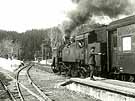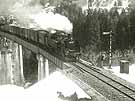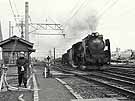Railwaymen
By Minoru Shinozaki
It seems that the second wave of "SL boom" is sweeping Japan (the first
one came around 1972, the centenary year of Japanese railway, when people
began obsessively recording the last days of steams).
In 1999, a film called Poppo-ya (Railwayman) based on Jiro
Asada's prize-winning novel was on show, attracting substantial
audiences. NHK broadcast a drama serial titled Suzuran (Lily of the
Valley), which is about an orphan girl brought up by a stationmaster of
a local line in Hokkaido and includes many scenes in which a steam
train runs in snow-covered countryside. NHK chartered Mooka-based C12
66 on Rumoi mainline (having brought her all the way to Hokkaido) for
it in December 1999. Also, a weekend steam special "Suzuran Go" started
operation in May there, which was hauled by newly revived C11 171 and
she, too, appeared in the drama. Along with her, C57 180, which began
operation of "Ban'etsu Monogatari Go" on the Banets-west line in April,
was last year's biggest news for railway enthusiasts.
It was no accident that the revival of steam was related to the
production of a drama featuring a railwayman. For many of us, the
railway stands for the old way of living in which communal life has not
yet lost its value. It stands for the value we have lost, living in a
fragmented society, for which automobile is a proper metaphor. At the
centre of our image of the old communal life is railway station and
railwaymen -- at least for me.
Nicholas Whittaker's Platform Soul (Indigo, 1995) is good
reading for all railfans especially because it describes vividly the
way of thinking and behavioral pattern of an endangered species called
"trainspotter". Bunking sheds" is the most interesting topic in this
book. It gives an impressive episode in which the author, as a
teenager, was arrested by the watchman for attempting to "bunk"
Stewarts Lane sheds, South London (serving Victoria Station services),
who threatened to call the police and make him cry furiously.
Compared with the British image of railwayman shown here,
Japanese counterpart is far milder. Dressed decently in a navy blue JNR
uniform (or white one in summer), a railwayman, always ready to answer
our inquiries, was a symbol of railway and a personification of
reliability for trainspotting boys. Japanese railwaymen in my memory
were kind and receptive to trainspotting boys. Some drivers let us in
the cab and showed how to stoke while the train was calling at way
stations. When we went out to shoot steams on local lines, we first
went to the station office to get information about train times and ask
for permission to photograph by the track. At many stations they gave
us train times on blueprint paper and showed us the way to good places
to take photos.
I particularly remember one young assistant stationmaster called
Mr. Ishida. I met him in March 1971 at Takiya on Tadami line (which now
connects Aizu-Wakamatsu, Fukushima pref. and Koide, Niigata pref., but
at
that time, the middle part of the line had not yet been opened and the
north part was called the Aizu line). After sending off the departing
train which I got off, he told me the train times and showed how to get
over the portal of the tunnel which was situated just beyond a high
bridge. I crossed the bridge walking on the catwalk, which was over 30
meters high to get to the spot. That was the first time I walked across
a railway bridge and I was excited (and a little scared) as I looked
down and saw the river below. I heard the river chattering and calls of
cuckoo echoing among the mountains in the warm sunlight of spring.
Thus, unlike
Whittaker's, all of my memories with railwaymen are sweet.

A young assistant stationmaster sending off a C11-hauled train at Takiya on Tadami (then Aizu) line in March 1971.
|

A C11-hauled crossing a bridge near Takiya on the same day.
|

A signalman in front of a signal box near Tsuruoka on U'etsu mainline in
autumn 1973.
|
[Home Page]


